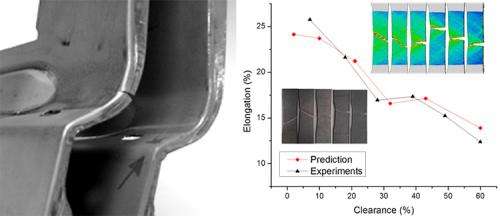Simulation models can prevent sheet failures in automobile alloy materials

As part their ongoing work with Ford Motor Company, Pacific Northwest National Laboratory scientists from the Applied Computational Mathematics and Engineering (ACME) group in the Computational Sciences & Mathematics Division have developed an integrated manufacturing process simulation framework that enhances their understanding of what occurs as AA6111-T4 aluminum alloy sheets, a quality material primarily used for automotive paneling, undergo shearing or trimming in preparation for the subsequent forming process. Their simulations showed how manufacturing processes influence material failures by providing a more complete picture of tensile failure behaviors of previously trimmed edges. Under various trimming conditions, their framework predicted tensile stretchability decreased with increased trimming clearances-in quantitative agreement with experimental measurements obtained by Ford.
To achieve higher fuel efficiency standards, car manufacturers consistently seek to use advanced lightweight materials to build their vehicles. AA6111-T4 aluminum alloy sheets afford a good combination of strength and ductility for automotive paneling. However, edge fracture and splitting often are observed in the stamping process for AA6111-T4 sheets prepared with traditional trimming equipment. The ability to predict what aspects of the trimming process contribute to edge fractures in these quality materials could generate lighter, more durable alloy sheets and further improve automobile fabrication. The method also could be used to examine the tensile stretchability of other materials, such as steel sheets.
In developing an integrated computational manufacturing process simulation framework, the researchers considered the tensile failure behavior of previously trimmed edges on AA6111-T4 aluminum alloy sheets. Their model incorporates the trimmed edge manufacturing history, including burr (metal flakes that form after machining) geometry, initial plastic deformation (irreversible shape change), and damage during the trimming operation, along with other information, such as grain distribution and an appropriate damage model. Their framework uses Python, a high-level computer programming language, to pass trimming simulation results to the subsequent finite element stretching simulations.
"Our goal with this work was to develop an integrated modeling framework for predicting tensile stretchability by considering multiple factors, most importantly the manufacturing history the sheet has gone through," explained Dr. Xin Sun, a PNNL Laboratory Fellow and the ACME group leader. "We want to be able to identify the key factors that are detrimental to trimmed edge stretchability and provide practical solutions to mitigate edge fracture in production."
The team was able to predict consistent failure modes and tensile ductility under different trimming conditions. They also found that annealing can improve the tensile stretching ductility of trimmed aluminum sheets. In addition, they discovered that deburring, a technique long employed in industrial practice after trimming for safety in handling and surface quality concerns, has only minimal influence on ductility and planar failure modes.
The researchers intend to further examine various options for improving formability of previously trimmed aluminum sheets guided by the validated simulation toolkit.
More information: Hua XH, X Sun, SF Golovashchenko. 2014. "Predicting Tensile Stretchability of Trimmed AA6111-T4 Sheets." Computational Materials Science 85:409-419. DOI: 10.1016/j.commatsci.2014.01.015.
Provided by Pacific Northwest National Laboratory





















